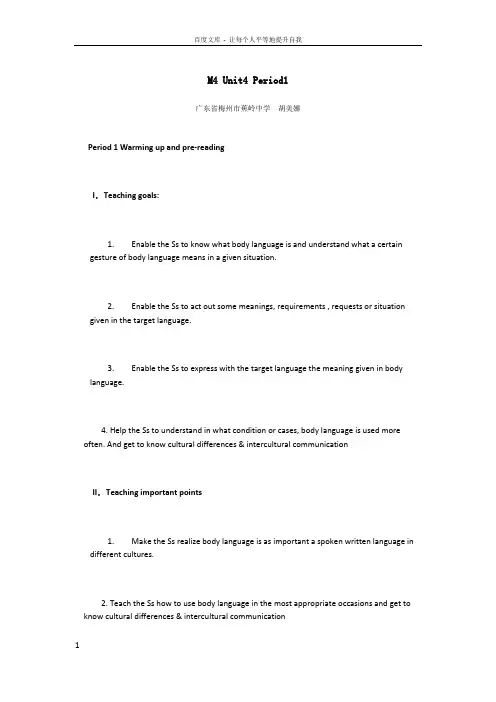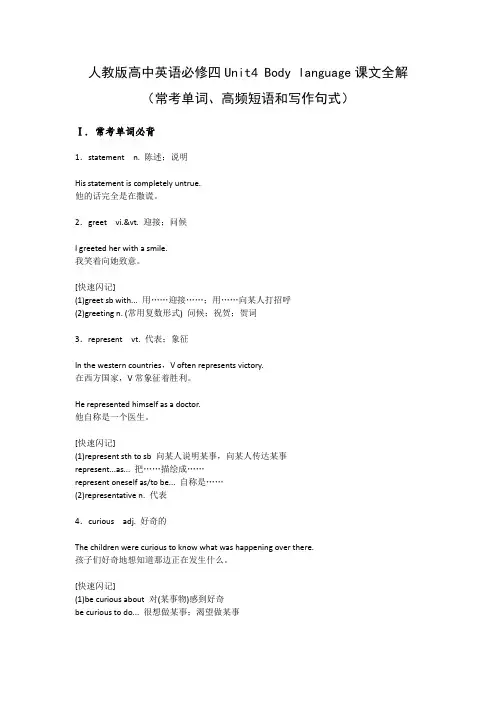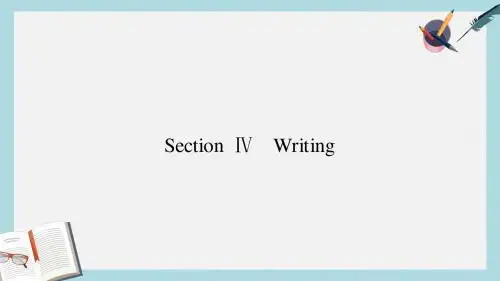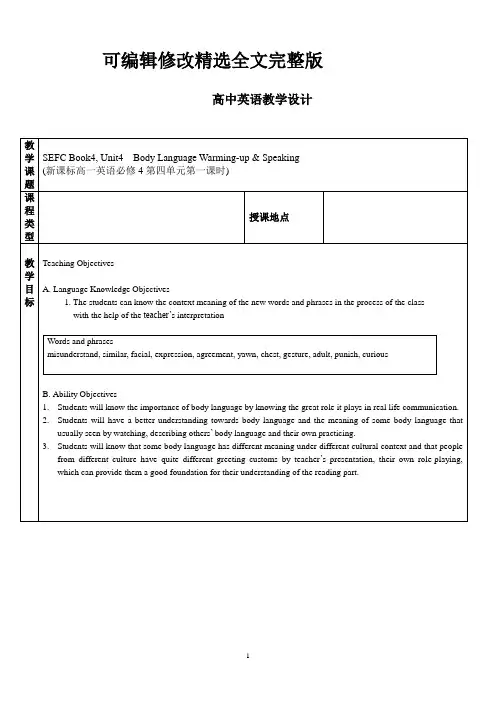2016-2017年人教版高中英语必修四_unit4_Body_language_Warming_up精品ppt课件
人教版高中英语必修四_Unit4_Body_Language-ReadingII课件(人教新课标)

madeofcanruohanxing
Unit 4 Body Language
Warming up ( 10 m )
Usually what gestures we will do ?
I am tired.
I am full.
I am hungry.
press palms/rest your head on it/ eyes closed
smile
A smile can hide other feelings, such as anger, fear or worry.
A smile does not always mean that one is happy.
Discussion ( 5m )
Post –reading Disctory!
quiet
stop
Discussion :
1.What is the function of body language? 2. What do think the role of body language in our daily life? 3. Are all the body language the same in the world? What do you know about them?
to show no interest to the person
6. standing, holding your arms across your chest
to protect yourself from an unwanted conversation
similar body language
similar body language
2017人教版高中英语必修四Unit4Bodylanguageperiod1

M4 Unit4 Period1广东省梅州市蕉岭中学胡美娜Period 1Warming up and pre-readingI.Teaching goals:1.Enable the Ss to know what body language is and understand what a certain gesture of body language means in a given situation.2.Enable the Ss to act out some meanings, requirements , requests or situation given in the target language.3.Enable the Ss to express with the target language the meaning given in body language.4. Help the Ss to understand in what condition or cases, body language is used more often. And get to know cultural differences & intercultural communicationII.Teaching important points1.Make the Ss realize body language is as important a spoken written language in different cultures.2. Teach the Ss how to use body language in the most appropriate occasions and get to know cultural differences & intercultural communicationIII.Teaching difficult pointsEnable the Ss to realize the importance of body language in communication so that little or no misunderstanding may occur.V.Teaching MethodsSkimming method, task-based method, role-play method.VI.Teaching Aids:A recorder, a projector, a computer, and the blackboardVII.Teaching procedures and waysStep 1 Enjoying the songPlay the song<If you are happy> and complete the words of the song. Then sing the song together.If you’re happy and you know it, Clap your hands;If you’re happy and you know it, never be afraid to show itIf you’re happy and you know it, Stomp your feet;If you’re happy and you know it, never be afraid to show itIf you’re happy and you know it, wink your eyeIf you’re happy and you know it, never be afraid to show itStep 2 Lead-in1. Show the pictures of Charlie Chaplin and talk about them briefly.1) . Who is the funny man in the film?2) How do they express themselves? (By what they do and their facial expressions.)3) What do you call that? (Body language.)2. T:Every day we need to communicate with each other. What do we use tocommunicate ? ( language )T: What’s the p urpose of language? ( To express ourselves and communicate with each other )T: Do you know how many ways of communicating are used?( spoken language/ written language / body language … )3.The teacher show some body language including facial expressions and gestures , students guess.Step 3 Free talkPresent some pictures of gestures. Get the Ss to describe the actions of the gestures and tell what they mean.1.the thumb and the forefinger putting together to form a circle with the otherfingers open. (OK.)2.The left palm putting on the forefinger of the right hand. (stop )3.putting your forefinger to your lip.(be silent)4. a thumb up .(well done )5. a v-shape of the forefinger and middle finger.( May you succeed. OrCongratulations on your success)6. a clap of hands ( come on / be cheerful)T: You have all done a good job. So you see that there are many cases or situations in which body language can convey meanings as well as spoken or written languages. If you want to know more about it, let’s come to Unit 4 Body Language.Step 4 Practice in pairs (warming up)T: Just now when I came in, I saw you were sm iling. And I know you’re happy. Besides,do you know any other common body language? Or can you give me some examples of body language and its meaning?Now let’s discuss in pairs about the pictures on page 25, what do the pictures mean?Ask several pairs to do the activity in front of the class.T:let’s conclude the ways in which you can show your body language.(eye contact, facial expressions, gesture, posture and so on)So we know we can use facial expressions, postures and gestures to express ourselves instead of saying a word. (Definition for body language)Body Language is a way of communication without using any words, including gestures、facial expressions、postures and so on.Step 5 Time for FunHave Ss act out the phrases in groups without speaking. (Ss’ book ,Page 25, Part II)Then get some groups to act out in front of the class. (Have a competition among groups to see which acts best , which helps to arouse the students’ interest.)Step 6 Pre-readingTalk about the questions in pairs then check them as a whole class.Step 7 SummaryT: Let’s make a summary about what we have learned in this period.1.What’s body language?( a way of communicating with each other without using words, including gestures、facial expressions、postures and so on.)2.What’s the purpose of body language?( It is acted as a tool of communication and help us to make other understand us better.)3.How do you use body language? Or in what cases or situation can we use bodylanguage?1). In a football game, a basketball game, the coaches use it often2). While talking to someone who doesn’t speak my language.3). Use it while we’re talking4). A traffic police use it while working.5). Some deaf and dumb people use it often….Homework1. Surf the internet to collect more information about Body Language2. Do a research on the body language in different cultures. And try to find some vivid examples about it3. Preview the reading passage and finish the exercises on Page 27. Then prepare for role play the reading in four groups。
人教版高中英语必修四Unit4 Body language课文全解(常考单词、高频短语和写作句式)

人教版高中英语必修四Unit4 Body language课文全解(常考单词、高频短语和写作句式)Ⅰ. 常考单词必背1.statement n. 陈述;说明His statement is completely untrue.他的话完全是在撒谎。
2.greet vi.&vt. 迎接;问候I greeted her with a smile.我笑着向她致意。
[快速闪记](1)greet sb with... 用……迎接……;用……向某人打招呼(2)greeting n. (常用复数形式) 问候;祝贺;贺词3.represent vt. 代表;象征In the western countries,V often represents victory.在西方国家,V常象征着胜利。
He represented himself as a doctor.他自称是一个医生。
[快速闪记](1)represent sth to sb 向某人说明某事,向某人传达某事represent...as... 把……描绘成……represent oneself as/to be... 自称是……(2)representative n. 代表4.curious adj. 好奇的The children were curious to know what was happening over there.孩子们好奇地想知道那边正在发生什么。
[快速闪记](1)be curious about 对(某事物)感到好奇be curious to do... 很想做某事;渴望做某事(2)curiously adv. 好奇地5.approach vt..&vi.接近;靠近;走近n. 接近;方法;途径As summer approached,the weather became hotter and hotter.随着夏天的临近,天气越来越热了。
人教新课标英语必修4全册教案(Unit 4 Body Language)

人教新课标英语必修4全册教案(Unit 4 Body Language)一、教学目标1.掌握与身体语言相关的词汇和短语;2.学习运用不同的身体语言表达自己的情感和意图;3.能够理解并能运用与身体语言相关的语法结构;4.培养学生的说、听、写、读的能力;5.培养学生的团队合作与表达能力。
二、教学准备1.教材:人教新课标英语必修4全册;2.PowerPoint 展示课程教学内容;3.音频设备。
三、教学计划第一课时:词汇与短语教学1. 导入(5分钟)通过展示一些身体语言的图片,引发学生们对身体语言的兴趣,并让他们猜测图片中人物的情感和意图。
2. 新词学习(15分钟)在讲解的过程中,通过多媒体展示相关的图片或动作以加深学生们的理解与记忆。
- Body language:身体语言 - Gesture:手势 - Facial expression:面部表情 - Posture:姿势 - Maintain eye contact:保持眼神交流 - Nod:点头 - Shake hands:握手 - Hug:拥抱 - Bow:鞠躬 - Smile:微笑3. 短语学习(15分钟)•Get along with:与…相处融洽•Make friends with:与…交朋友•Show respect for:对…表示尊敬•Be fond of:喜欢•Play a role:起作用•Be ashamed of:以…为羞耻•Be confident in:对…有信心•Have a positive attitude:持积极态度•Pay attention to:注意4. 听力练习(15分钟)播放相关录音,要求学生根据所听内容填写相应的单词或短语。
可以将答案呈现在 PowerPoint 上进行批改,同时让学生自己检查正确率。
5. 小结(5分钟)对所学的新词和短语进行小结。
鼓励学生积极参与,对不清楚的地方进行反复澄清。
第二课时:语法与句型教学1. 导入(5分钟)通过一个与身体语言有关的小故事或情景,引发学生们对身体语言的思考和讨论。
人教版高中英语必修四Unit 4《Body language》ppt课件4

思路点拨 素材积累 实战成篇
肖刚是2016年里约奥运会上的一名志愿者,在服务中得知不同国 家的身势语在不同的国家有着不同的含义。现就在服务中所了解 的有关这方面的知识写信告诉好友李华。信件要包括以下内容:
1.不同文化有不同的身势语; 2.法国人热情,见到熟人互相握手,亲吻彼此的脸; 3.一般来说,世界上大部分国家的人见面都握手,但日本人更喜欢 鞠躬; 4.不同的身势语无所谓好与坏,但了解它们可以增进了解,减少误 解,避免交往中的困难。 注意: 1.使用书信的格式; 2.不要逐字逐句地翻译要点,可根据需要适当增加。
As we all know,every culture has its own body language.Take greetings for example.The French are open-minded.They shake hands and kiss each other on each cheek when they meet people they know.In general,people from most countries in the world now greet each other by shaking hands,but the Japanese prefer to bow.
思路点拨 素材积累 实战成篇
一般信件开头常用的句式: ①Glad to write to you! ②I beg to take this opportunity to inform you that... ③I’m very much delighted to inform you that... ④I would share... with you. 介绍body language 时常用的句型: ①As we all know,every culture has its own body language. ②Shaking hands is used by most countries. ③Take...for example. ④None of the actions is good or bad. ⑤Learning the customs of different cultures can avoid
人教版高中英语必修四-Unit-4-Body-L精选全文完整版

可编辑修改精选全文完整版高中英语教学设计教学过程设计活动内容StepII导入A. Group Discussion The Different Ways of Communication ( 3 min )Hold an activity of group discussion among the class on the question “What are the different ways of ofcommunicating in daily life?”Divide the class in to 8 groups, and give them 2 minutes for discussion about the above question. After discussion, several students will be asked to express their ideas. The teacher will add their answers around the circle.Blackboard Design (板书设计)In the center of the circle ,there will be the words “different ways of communicating …” and the teacher will aid their answers around the circle. They are also supposed to give an example for their answers.Possible Answers AreBy talking, speaking, phoning, writing letters, sending e-mails, using gestures, etcB. The Teacher ’s Categorizing of The Students ’ Answers ( 1 min )In this step, the teacher will try to help the students to categorize their answers, making them know that body language is as important a way as spoken or written language in communication.Blackboard Design (板书设计)Step 2介绍身势语的重要性A.Telling Students the Story of Tai Lihua and Making Them Know theImportance of Body Language in Her Life ( 3 min )1.Present the pictures of Thousands of Hands Kwan-yin , and ask the students whether they know thegirl who dances in the front.2. Tell the students tell life story of Tai Lihua and ask them the question “What are the key factors for her success in her life?”writingtypi ngSpoken languageWritten languageBody language gesturingspeakingringingverballanguageNon-verballanguageThe life story of Tai LihuaHer name is Tai Lihua(邰丽华). She is called a Fairy of Peach blossom(桃花仙子) by people. You knowshe is a deaf girl, but she is a wise, diligent, charming and energetic girl. She studied very hard and got two degrees of bachelors in university. She was famous as an artist for her wonderful performance. She is deafand dumb. But how did she get that great achievement and became a successful person? She loves life very much. We should learn from her spirit. Besides her hard working, body language plays a very importantpart in her life. We are all healthy people, sometimes we can use body language to express ourselves. Sowe should pay more attention to learning body languages.B.Showing the Students the Science Report of the Importance Body Language, Making Them Know That Body Language Is As Important For Us As ForDisabled Person Like Tai Lihua. ( 1 min )Some psychologist believe that we communicate 65% of our ideas and feelings without words! The shapeof our bodies and faces, the movements and gestures we make, the clothes we wear, how near we stand to each other and whether we touch each other…all these communicate. we must study all these types of information if we want to truly understand what other people are saying.Step 3介绍不同类型的身势语() ( step 3 will use around 5 min )A. Showing the Students The Four Types of Body LanguageGestureFacial expressionEye contactPostureB. Guessing The Meaning of GesturesThe teacher show the students a series of pictures of a man using different gestures, and the students are supposed to say their meaning.C. Acting Out By GesturesThe teacher show the students some English words and ask them to act them out together by usinggestures.D. Chasing the Right WordThe teacher will show the students a series of pictures describing different facial expressions and askthe students to choose the right word for each.Victory! Ok !Be quiet! You!Threatening No. sixThank you ! Congratulations!E. Matching the Right Interpretation Of the EyesThe teacher will present students several pictures of eyes and ask the students to match the right interpretation.Facial expressionanger fear joy sorrow contempt轻视surprise disgust 厌恶What do you see in the eyes below?That’s a problem. I need to thinkfor while.a whileIt’s you! Let’s have a duel!That’s horrible! I’m terrified!The next minute,you’re a dead body!I’m in great sorrown ess…I won’t give up! We’ll soon winback!F. Guessing The Meaning of Postures in Real ContextI’m listening carefully!What do we know from their posture?Nice to meet you!This woman is listening to your ideas…You meet this man for the first time…Give me a little time!I’m still thinking!You are asking this womanTo finish her work as soon as possible…You are asking this woman ”Have you got any good idea?” …I give up!OK!You are asking help from this woman…You are saying “Will you give up!”…G. Matching the Right Meaning of the Given Posturesnervous Bite your nails and fondle hair agreement Nod the head up and downBe not interested Look away or yawn.Do not believe Roll your eyes and turn your head away. angry Frown and turn your back to sb disagreement Shake the headStep 4给身势语下定义A.Finishing the First Question of Warming-up Part ( 3 min )The teacher will ask the students to discuss the question with your partner and try to find what the people in the pictures are communicating.B.Giving Definition To Body Language ( 2 min )The teacher will guide the students to give a general definition to body language.Body languageis a form of non-verbal communication.uses movements or positions of our body to show other people what we are thinking or feeling.mainly includes gesture, facial expression, eye contact, posture four forms.Step 5练习运用身势语A.Acting Out the Following words ( 4 min )This exercise is based on the second question of warming-up part. Two students will be chose to the frontof the class, and each of them will choose five words to act. After their action, other students will try to guess which word they have acted.•Hello!•Goodbye!•Go away!•Expensive!•I’m surprised!•I’m tired•I’m confused!•Good luck•I’m delighted!•I’m upset!•I’m sad!•I forgot!•You are great!•I’m curious!•I ate too much!•Come here!B.Acting Out the Dialogue on Page 67 ( 10 min )The student will work in groups of two to finish the speaking task of this unit on page 67. They are required to use appropriate body language as they are making dialogues. After their pairwork, volunteers will make their dialogue before the whole class.Step 6介绍身势语的文化多样性A.Showing the Cultural Difference in Body Language With Examples ( 2 min )America OKJapan moneyFrance zeroBrazilGermanyrudeB . Presenting the Students the Major Greeting Customs in the World ( 2 min )Person and country Suitable greeting A man from ColumbiaTo a man: same as for a womanTo a woman: touches her shoulder and kissesher on the cheekA woman from BritainTo a man: not to close, shake hands To a woman: shake hands, will get closeA man from JapanTo a man: bowsTo a woman: bowsA man from CanadaTo a man: shake handsTo a woman: shake hands or kisses on both cheeks if knownA woman from FranceTo a man: shake hands, kisses twice on the cheekTo a woman: same to someone she knowsA man from the Middle East or some Muslim countriesTo a man:comes close, shakes handsTo a woman:nodsC. Discussion On the Question That If There is a Division of Good or Bad of the Different Meaning of The Same Body Language Under Different Culture.The students will have 3 minutes for discussion and after that some of them will represent their group to share their idea with the whole class.Step Role Play ( 8 min )USA Nigeria rude Germany Japanone“great”or “good job”。
高中英语人教版必修四Unit_4_Body_Language
1.Whatisthepurposeoflanguage?
2.Howcanyoutellifsomeoneissadeveniftheydonotspeak?
3.Whatwouldyoudoifyouneedtheother’shelpurgentlywhileyoutwospeakdifferentlanguages?
Somebodylanguagesinsomecountriesaregoodwhilesomecountries’bodylanguagearebad.
【活动设计说明】
找段落大意,理解文章的写作手法和理解文章的细节信息,是在阅读过程中要训练学生的方法。这样能够协助学生从整体上把握文章,并能培养学生迅速捕捉整体信息的水平。在Task2局部通过判断对错的训练让学生能更进一步理解文章的细节信息,知道不同的国家不同的文化影响bodylanguage也是不同的。
【活动设计说明】
通过互动表演以及头脑风暴使学生对bodylanguage有了初步理解,而且通过这些活动调动学生的兴趣,为reading做好铺垫。
Step2Pre-reading
T:Ourtextisaboutaspecialmeansofcommunication—BodyLanguage.Nowpleaselookatthescreen.Anddiscussthesequestionswithyourpartnerfirst.Andthensomeofyouwillbeaskedtoreportyourwork.Areyouclear?
PWPapproach在阅读中使用检索读的学习策略
四、 教学过程
Step1Warmingup
Task1.Brainstorm:thewordsofemotions/feelingsofhumanbeings
人教版高中英语必修四Unit Four Body language
高中英语学习材料(灿若寒星*制作整理)Unit Four Body language课程标准中的内容标准:本单元的的中心话题是“身势语”。
了解身势语的不同文化涵义并正确地加以运用,会在交际场合中起到意想不到的好效果。
单元各项活动的设计都围绕着这个主题进行。
教学细目:1、(情感目标)通过对各种身势语的学习,正确地理解和运用身势语,以达到良好的交际效果。
2、(交际)学习掌握常用的表示“禁止”、“警告”、“义务”的用语。
3、(词汇)通过阅读、师生互动掌握本单元的教学目的和要求中的词汇。
4、(写作)通过口语交流和书面训练,学习并掌握写封短信,询问朋友发生了什么以及是否需要帮助。
5、(语法)通过阅读理解和书面训练,学习掌握动词的-ing形式作定语、状语的用法,并对该项语法内容做一小结。
学习领域与主题内容及要求目标层次人教版必修四UnitFourBodylanguage理解掌握运用1.1.1. 话题:Cultural differences andintercultural communication√1.1.2功能(通过听和说,能在生活中运用下列英语进行交际):1. Prohibition and warning(禁止和警告)Always stay … Do not …Stop! Keep away from …Go away. Don’t enter here.Watch out! Look out!Be careful when … Be quiet.√Come here. You may not …You’ll be fined (200) yuan.Don’t smoke here.Be careful! Don’t slip.2. Obligation(义务和责任)You must … You should never …You’ll be … You’ll have to …You will need to …√1.1.3 Understanding vocabulary(理解词汇)(通过听、看、阅读,能理解下列词汇含义。
人教版必修四unit 4《body languange period 1reading》优秀教案(重点资料).doc
英语:Unit 4 Body languange Period 1Reading优秀教案(新人教版必修4)The General Idea of This PeriodThis period includes Warming up,Reading and Comprehending of Unit 4.It introduces the body language from different countries.Students will enlarge their knowledge of body language by reading the text and communicating with their peer.Meanwhile the students can learn more body language from speaking,listening and acting.Students should think carefully about that body language have different meanings in different cultures.Students are encouraged to think about the purpose,forms and functions of body languages.Students will realize the importance to understand different body language in different cultures and they are alsoencouraged to use the body language appropriately.Teaching Important PointsHelp the students understand the passage better.Learn and master some important words and phrases in this period.Help the students to understand the details of the text byhelping them to accomplish the exercise and activities.Teaching Difficult PointsHow to help the students improve their reading ability andunderstand the passage better.How to master the important language points in this passage.How to help the students understand and use the body language appropriately.Teaching MethodsFast reading to get the general idea of the text.Careful reading to understand the passage better.Explanation to help the students master some language points.Discussion to help the students understand better what they’ve learned and to use the knowledge they’ve learned in this period.Teaching AidsA tape recorderThe multimediaThree Dimensional Teaching AimsKnowledge and SkillsTrain the students’ reading ability.Learn some useful words and expressions:major,local,represent,curious,introduce,approach,touch,cheek,stranger,spoken,express,action,likely,nod,general,avoidEnable the students to sum up the main idea of each paragraph.Enable the students to understand different body language indifferent cultures.Process and StrategiesAct-and-guess to make the students involve in the class actively.Fast reading to make them get the main idea of the passage.Feelings and ValueThe teacher may approach this part by asking them to act some body movement,which can not only help them get ready for the learning of the passage,but can acquaint them with different gestures in and outside China.Teaching ProceduresStep 1 Lead in1.Play a song to the students and ask them to act to the music.If You’re HappyIf you’re happy and you know it,clap your hands.(clap,clap)If you’re happy and you know it,clap your hands.(clap,clap)If you’re happy and you know it,and you really want to show it.If you’re happy and you know it,clap your hands.(clap,clap)2.Introuduce gesturesT:Boys and girls,why not move our bodies to get relaxed.Let’s do it together!I will say some words and you will act their meanings out.First,raise your hands.Ready?Go!(The teacher says out the wordsas follow and the students do the gestures.)Well done! Victory!Stop! Quiet!OK!3.Introduce the facial expressionsT:Good job!Now relax your face.Show the facial expression to express the following feelings.surprised angryfear joydisgust4.Intoruduce the posturesT:Excellent!Now relax your whole bodies.We are going to move our whole bodies.You are expected to do the movement with your partners.nodbowhug handshake5.Introduce the eye contactT:Well done!Now use your eyes to express your feelings in the following situations.Situation one:Suppose today is your birthday,you receive a very big present.It’s as big as you.So when you see the present,what’s your response?(answer:wide eyed)Situation two:Suppose you are walking on the street,some ugly guy comes up to you and wants to talk to you to get your telephonenumber.What’s your response?(answer:roll eyes)Situation three:Suppose you are walking on the street,some handsomeguy walks by you.What’s your response?(answer:wink)6.Summarize what’s body languageBody language is a form of communication without using any words and it can help us express our feelings.Now look at the picturesand guess what the man means by his body language?Come here!Bad!Good!Me?Good luck! I don’t know!Step 2 SkimmingT:First,I would like you to skim the text and find the names of the persons mentioned and the countries they come from.Time is limited to 2 minutes.Step 3 ScanningT:Now you have got all the characters in the text.For this time,I would like you to scan the text and find out the actions (body language) mentioned in the passage and then act them out in pairs.The following chart may help you find the movement.Time is limited to 4 minutes.Suggested answer:Step 4 Intensive ReadingAsk the students to look through the questions on the screen and read the text silently.Students are expected to find out all the answers by themselves.T:OK,boys and girls.You have done a good job.Now let ’s read paragraphs 2-3 and find out the mistakes by using different body languages.How do the mistakes happen?Time is limited to 4 minutes.After 4 minutes,ask the students whether they’ve got the answers.T:Now who would like to be the first one to tell me how many mistakes you have found?S1:There are two mistakes at the airport by using different body language.T:What’s the first mistake?And how does it happen?S2:Mr.Garcia from Columbia approaches Ms.Smith,touches her shoulder and kisses her on the cheek.Julia Smith from Britain steps backappearing surprised and takes a few steps away from Mr.Garcia.T:Good!Who would like to talk about the second mistake?S3:The second mistake happens between a Japanese and a Canadian.A Japanese bows to Mr.Cook and his nose touches Mr.Cook’s moving hand,when Mr.Cook from Canada reaches his hand out to the Japanese.T:Excellent!You have understood different body language in different cultures.Now let’s move on to paragraphs 3-6 and finishthe following true or false exercise.1.Englishmen often stand close to others or touch strangers as soon as they meet.2.Most people around the world now greet each other by kissing.3.Japanese will bow to others as greeting.4.People from Jordan will move very close to you as you introduce yourself to them.5.Some body languages in some countries are good while some countries’ body languages are bad.Suggested answers:1.F2.F3.T4.T5.FStep 5 Divide the passage and find the main idea of each part T:Now you have totally understood the passage.I would like you to divide the passage into 4 parts and sum up the main idea of eachpart.You can discuss in the group of four.After the discussion,ask some students about their opinion.T:OK,which group would like to share your idea with us?S:Part 1:Para 1.The main idea is you are sent to Pudong Airport tomeet business people.S:Part 2:Para 2-3.It mainly talks about the examples of learned or cultural “body language”.S:Part 3:Para 4-5.It tells us that different peoples have different body language.S:Part 4:Para 6.It’s the summary of body language.Step 6 Retell the storyT:Since you have read the text for three times,I guess you havetotally understood the text.Now let’s check whether you have comprehended the text.On the blackboard,it’s the summary of our reading text.But it’s not complete.You have to think out a proper word to fill in each blank without reading your textbook.After filling the missing words,you will have a complete summary of thetext.Now,I will give you 5 minutes to do this task.My boss has sent me to Pudong Airport to meet some _________ people from many parts of the world,who are interested in the_________ of business in China.The first one to arrive is Mr.Garcia from Columbia with Julia Smith,a British lady,_________ behind closely.I _________ them to each other andI’m _________ to see Mr.Garcia comes up to Ms Smith.Just then,a visitor from Japan,comes in and __________ when the Canadian,Mr.Cook __________ out his hand to him.It happens that Mr.Cook’s hand __________ the Japanese’s nose as he bows andthey both __________.So you see,people from __________ cultures may not __________ others in the same way.English people usually do not __________ very close to others or touchthe __________ as people from Spain,Italy and South American countries do.Most people around the world __________ hands whenthey meet while __________ people will bow.People from Jordan stand quite __________ to other men and shake hands and kiss others on the __________.In a word,body language differs indifferent cultures and is widely used in __________.Suggested answer:My boss has sent me to Pudong Airport to meet some business people from many parts of the world,who are interested in the development of business in China.The first one to arrive is Mr.Garcia from Columbia with Julia Smith,a British lady,following behind closely.I introduce them to each other and I’m surprised to see Mr.Garcia comes up to Ms Smith.Just then,a visitor from Japan,comes in and bows when the Canadian,Mr.Cook reaches out his hand to him.It happens that Mr.Cook’s hand touches the Japanese’s nose as he bows and they both apologize.So you see,people from different cultures may not greet others in the same way.English people usually do not stand very close to others or touch the strangers as people from Spain,Italy and South American countries do.Most people around the world shake hands when they meet while Japanese people will bow.People from Jordan stand quite close to other men and shake hands and kiss others on the cheek In a word,body language differs in different cultures and is widely used in communication.Step 7 Language Points FocusT:So much for the exercises.Now look through the passage again andsee if you have any language problems.S:I don’t know what’s the meaning of the sentence “Not all culturesgreet each other the same way,nor are they comfortable touching strangers or being too close or too far away.”?T:This sentence means “不是所有人都以同样的方式寒暄。
人教新课标英语必修4全册教案(Unit4BodyLanguage)
人教新课标英语必修4全册教案(Unit 4 Body Language) Unit 4 Bd LanguagePart ne: Teahing Design Teahing gals1 Target Languagea 重点词汇和短语isunderstand, siilar, faial, expressin, agreeent, an, hest, gesture, adult, punishb 重点句型或交际用语At ut the flling eanings, pleasePlease guess hat I eanPlease sh the atins, using bd languageN it is ur turn t sh the atin / gesturePlease use either spen rds r bd language t express ur ideasPlease use bth spen rds and bd language t express ur ideas2 Abilit galsa Enable the students t understand hat a ertain gesture f the bd language eans in a given situatinb Enable the students t at ut se eanings, requireents, requests r situatins given in the target languageEnable the students t express ith the target language the eanings given in bd language3 Learning abilit galsa Help the students learn h t express theselves in bd language hen neededb Help the students understand thers hen bd language is being usedTeahing iprtant pintsa Teah the students h t understand bd language used in different untries r ultures as ell as in different asinsb Teah the students h t use bd language in the st apprpriate asinsTeahing diffiult pintsa Enable the students t realize the iprtane f bd language in uniatin s that little r n isunderstanding a urb Let the students n that there is bth psitive bd language and negative bd languageTeahing ethdsa Individual r, pair r and grup rb Ating ut b iitatin, ie r ith gestures and bd veentTeahing aidsA puter, a pretr and se pituresTeahing predures ≈ asThe first perid reading(UNIATIN: N PRBLE?)AisT help students develp their reading abilit T help students learn abut bd language PreduresI aring uparing up b atingL at the list f interpretatin n the right side f the hart Perfr the atin r the nnverbal behaviur n the left sideExaples f Bd Languagearing up b defining—hat is bd language?II Pre-reading1 Ling and saingL at the an in the piture bel hat des he sa t u b his bd language?Basiall, h the d I n? r, I dn’t n nthin! The shulders are hunhed and the hands are pen signifing a big questin ar2 Taling and sharingBd language is the quiet, seret and st perful language f all!Arding t experts, ur nn-verbal language uniates abut 0% f hat e reall ean(vie tnalit ntributes 38%) hile rds theselves ntribute a ere 7%ur bdies send ut essages nstantl and ften e dn’t regnize that e’r lt re than e realizeur understanding and use f nn-verbal ues in faial expressin are failiar t usnearl fr birthIII Reading1 Reading alud t the rerdingN please listen and read alud t the rerding f the text UNIATIN: N PRBLE?Pa attentin t the prnuniatin f eah rd and the pauses ithin eah sentene I illpla the tape tie and u shall read alud tie, t2 Reading and underliningNext u are t read and underline all the useful expressins r llatins in thepassage p the t ur nteb after lass as her。
- 1、下载文档前请自行甄别文档内容的完整性,平台不提供额外的编辑、内容补充、找答案等附加服务。
- 2、"仅部分预览"的文档,不可在线预览部分如存在完整性等问题,可反馈申请退款(可完整预览的文档不适用该条件!)。
- 3、如文档侵犯您的权益,请联系客服反馈,我们会尽快为您处理(人工客服工作时间:9:00-18:30)。
Akira Nagata man from
Japan
man from kiss on the Tony Garcia Colombia cheek Julia woman no touching Smith from Britain bowing
everyone
everyone everyone
Name
out the main idea. Part 1. (para. 1) You are sent to Capital International Airport to meet this year’s international
students.
Part 2 (para. 2 and 3 ) Examples of learned or cultural “body language”. Part 3. (para. 4 ) Different peoples have different body
Choose the correct one.
Post reading
1. How do different international students behave when they greet
people? Complete the chart with
information from the passage .
Name
Description Body Language To Whom
Reading
Communication: No problem?
JapaneseAkira Nagata
George Cook (Canada)
Julia Smith (Britain)
Tony Garcia (Columbia)
Reading comprehension
While reading, please try to divide the whole passage into several parts and find
eye contact
Gesture a circle with one’s thumb and index finger
Country most countries Japan France Germany Brazil
Meaning OK money zero
rude
Comparison
Gesture in the USA No, don’t Moving the do that. index finger from side to side. I don’t Shrugging know one’s Meaning Gesture in China Moving the hand from side to side Shaking the head
Description Body Language To Whom
George Cook Ahmed Aziz Darlene Coulon
man from Canada man from Jordan woman from France
shaking hands everyone shaking hands to men nodding to women people shake hands she and kiss twice knows
languages. Part 4. (para. 5) Summary of body language.
Read the text carefully, then decide if the following statements are true (T) or false (F).
Байду номын сангаас
• Englishmen often stand close to others or touch strangers as soon as they meet. F • Most people around the world now greet F each other by kissing .
Good !
Bad!
Come here!
Good luck!
Me?
I don’t know!
Body language varies from culture to culture.
Gesture Meaning some countries show interest rude or other countries disrespectful Country
• Japanese will bow to others as greeting. T
• People from Jordan will move very close to you as you introduce yourself to them. T • Some body languages in some countries are good while someF countries’ body language are bad.
Meaning Gesture in the Gesture in USA China Well done Thumbs up. Thumbs up. Open one’s Incredible. Rolling one’s eye or mouth I can’t eyes. wide. believe it.
Body Language Warming up
What is body language?
Body language is one form of nonverbal communication (非言辞交 际) without using words. Eye contact, facial expression, gesture, and posture (姿势), or the way you stand, are different kinds of body language.
